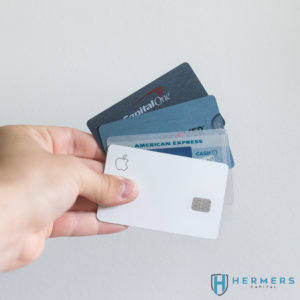
12 ways you can help handle your credit card debt
Generally speaking, some of the easiest ways to handle your credit card debt include:
- Paying the bills on time
- Charge higher than the required payment
- Change your spending habits
- Reducing the interest rate
- The use of a leverage plan to pay down debt
Here are 12 more ways to handle and pay off credit card debt.
1 – Learn how to use credit cards responsibly
When you’re working on getting out of your credit card debt, the first thing you want to do is consider the right use of your credit card.
Credit cards are nice to use for items like building your credit profile, collecting loyalty points, and a more safe method of payment than cash.
Using a credit card wisely often means paying the bills on time and on balance due. Failure to pay your bill on time would affect your reputation since the payment history is the largest thing you weigh when determining your credit score.
Significant amounts of debt would also have a negative effect on your credit score.
Don’t use a credit card to spend outside of your means. Alternatively, use credit cards to get what you need under your limits and your ability to pay back.
2 – Know your budget
The budget is a roadmap for how you’re going to handle your finances by counting down the dollars you raise and invest. The budget gives you a very good view of your financial life. It makes you mindful of the extra money that you have to invest or the lack of money that you have to spare.
Knowing your budget is a vital part of your financial management, and it tells you how much money you have to cover payments on time to pay off your loans.
Especially when it comes to paying off loans, you’re going to need to decide how much free cash flow you’re going to have to invest extra money on debt payments.
3 – Pay more than the minimum payment
With time, spending the minimum price would save you more money.
Why? Because when you hold the balance on your credit card, the debt will accrue interest on a regular basis. However, once you pay the entire amount by the due date, you will not be paid any interest.
For example, if you have just over $6,000 in credit card debt at an interest rate of 14.99 percent and a minimum payment of around $20, you might end up spending over $4,000 in interest before you pay off the initial balance.
4 – Understand your credit utilization rate
You’re still curious about what the use of credit is. The amount of credit usage is the ratio of how much-unused credit you have relative to how much you have available.
When you have $6,000 in credit card debt and $20,000 open for use, the usage rate is 30%.
Your credit usage rating is a significant part of what is used to assess your credit score.
Lower credit use means that your credit cards are not maximized and that you handle your credit well.
Higher credit usage levels may mean that you do not invest your money wisely and have higher amounts of credit card debt.
The ideal penetration of credit is below 30%. If it is over 30%, make reducing your loan usage rate a target in your credit card debt service strategy.
Lowering it will reduce your debt and increase your credit score.
5 – Improve your spending habits
When it’s wrong, you’ve got to patch it. Bad habits, like investing more than you earn, are not right. Adjust your spending habits in order to be more in line with the budget.
Implementation of money-saving strategies such as using discounts, shopping on sale, and an overall frugal lifestyle will help increase your expenses and save enough money to pay off your debt.
Taking time to build healthy financial habits is also part of a long-term approach to control loans and investments.
You don’t want to find a partial approach to healthier consumption. Instead, make a long-term lifestyle adjustment that will help you meet your financial goals.
6 – Review your credit report
Your credit report is a snapshot of both the previous and current lending transactions.
It lets you know for any creditor you owe money to. More specifically, it helps lenders know the past of your mortgage payments to decide whether they want to lend you money at what rate of interest.
Your credit report has an effect on your ability to borrow money, so you want to make sure that what it includes is reliable and constructive.
Mistakes in credit reports are fairly popular. Please check your documents to ensure that your personal details are accurate and that there are no debts reported that have not been accrued by you.
Often, check your account and make sure you know all the money you owe. It could be because you moved and owed money to a service company you didn’t know about. It is worth taking the time to check your credit report. It could save you money right now and heartache later by finding trouble early.
7 – Pay your bills on time
Late credit card fees are going to weigh down your credit score and save you more money.
Not paying the bill on time and in full would also lead to late fees. Avoiding late payments means making extra money that you can use to pay off your bank balance instead of contributing to what you owe.
The best way to ensure that the transfers are received on time is to set up automated online payments. You can use auto-pay from your bank or make transfers to your credit card provider. Having transfers automated would help you prevent any future late fees or penalties.
Only make sure that you are mindful of the processing times involved in moving your money.
Many banks require around three or four business days to move money. Often, make sure you have enough money in your account before you redeem the cash; otherwise, you could face a bill on the refunded payments.
8 – Get your credit card interest rate lowered
Your interest rate has a huge effect on your credit card balance. It’s the amount that you pay to borrow money. Having it down will save you a lot of money over time.
The best way to lower the interest rate on your credit card is to inquire. It looks too amazing to be real, but it doesn’t. If you have been paying your bills on time and have become a long-standing client, several credit card issuers (though not all) are able to help you out.
Author of “I Will Teach You to be Rich,” Ramit Sethi has a script you can use to call your credit card company to get your interest rates reduced.
9 – Use a debt strategy to pay off debt
Part of handling credit card debt involves making a commitment to cover what you owe, so you don’t want to incur life-long credit card interest.
There are three primary collateral default repayment strategies:
- The form of snowball
- The method of avalanche
- The “do what you should do” method.
Many individuals have varying points of view as to which strategy or solution is correct. I’m a great believer in doing what is best for you.
No matter what form you use, the bottom line, you’re already paying off your loans. And that’s the goal — to get out of debt.
Let’s break down the methods a little bit further so that you can determine which one is right for you.
Strategy #1 – the debt snowball method
Dave Ramsey made the Debt Snowball technique popular. The goal is to make fast progress in paying off debt and get you excited and inspired to get out of debt.
For the snowball process, the emphasis is on paying down the smallest debt you’ve got first. When the loan is gone, you “snowball” the money you used to fund the previous balance to the next lowest credit card debt.
You keep doing this until all of the debt is paid off.
Strategy #2 – the debt avalanche method
Under the debt avalanche method, the goal is to pay off your debt at the highest interest rate while continuing to make minimum payments on all of your other debts.
This approach could save you the most money on interest, but it may not be as motivating as the snowball approach.
Strategy #3 – the debt “do what you can” method
The “do what you can” approach is a combination of avalanche and snowball. The goal is to do what is best for you.
If you need some quick motivation to start with, try paying off one or two of your low balance credit cards.
Then you can switch to your debt at the highest interest rate. Or you can do it the other way around. Pay one credit card with the highest interest rate, and quickly pay off some of your smaller balances.
10 – Consolidate your debt
High-interest credit cards are the worst thing. High interest means you pay more for the money you borrowed. And many people don’t have a single high-interest rate card. They have multiple high-interest rate credit cards.
For some people in this situation, debt consolidation could be a way to help them reduce their interest payments.
Debt consolidation is when you take a high-interest rate credit card or other debt and roll it into one lower payment. Benefits are that your debt can be easier to manage, and you’ll save money on interest payments over time.
The two main methods of debt consolidation are a debt consolidation loan or a 0 percent interest credit card that enables a balance transfer.
With a debt consolidation loan, you’re taking the loan money and using it to pay off your credit card balances. Then you pay one payment for your new consolidation loan.
With your credit card balance transfer, you move your old credit card balance to your new card.
Knowing whether debt consolidation is good for you depends on your situation. If you don’t have a lot of debt and are in a position to pay off in a reasonable amount of time, debt consolidation may not be for you. But if you have a lot of high-interest debt, you might be talking to a financial coach or a debt management consultant.
Check out #12 on this list for more help connecting with a professional.
11 – Build an emergency fund
When you’re actively managing your credit card debt, the last thing you want is for a financial emergency to come along and confuse all your hard work. Building an emergency fund with a cash reserve of $1,500 to $2,000 will help you avoid putting emergency costs on your credit card.
A great way to start saving money is to make automatic transfers from your account to your savings account every month. Check your budget to see how much you can set aside to save each month.
12 – Find the help you need
It’s all right if you need some help. Don’t be afraid to find tools, resources, and services to help you manage credit card debt. You aren’t alone.
The NFCC Consumer Financial Literacy Survey shows that “around 24 percent of adults would reach out to a professional non-profit credit counseling agency for assistance if they had financial debt problems.”



